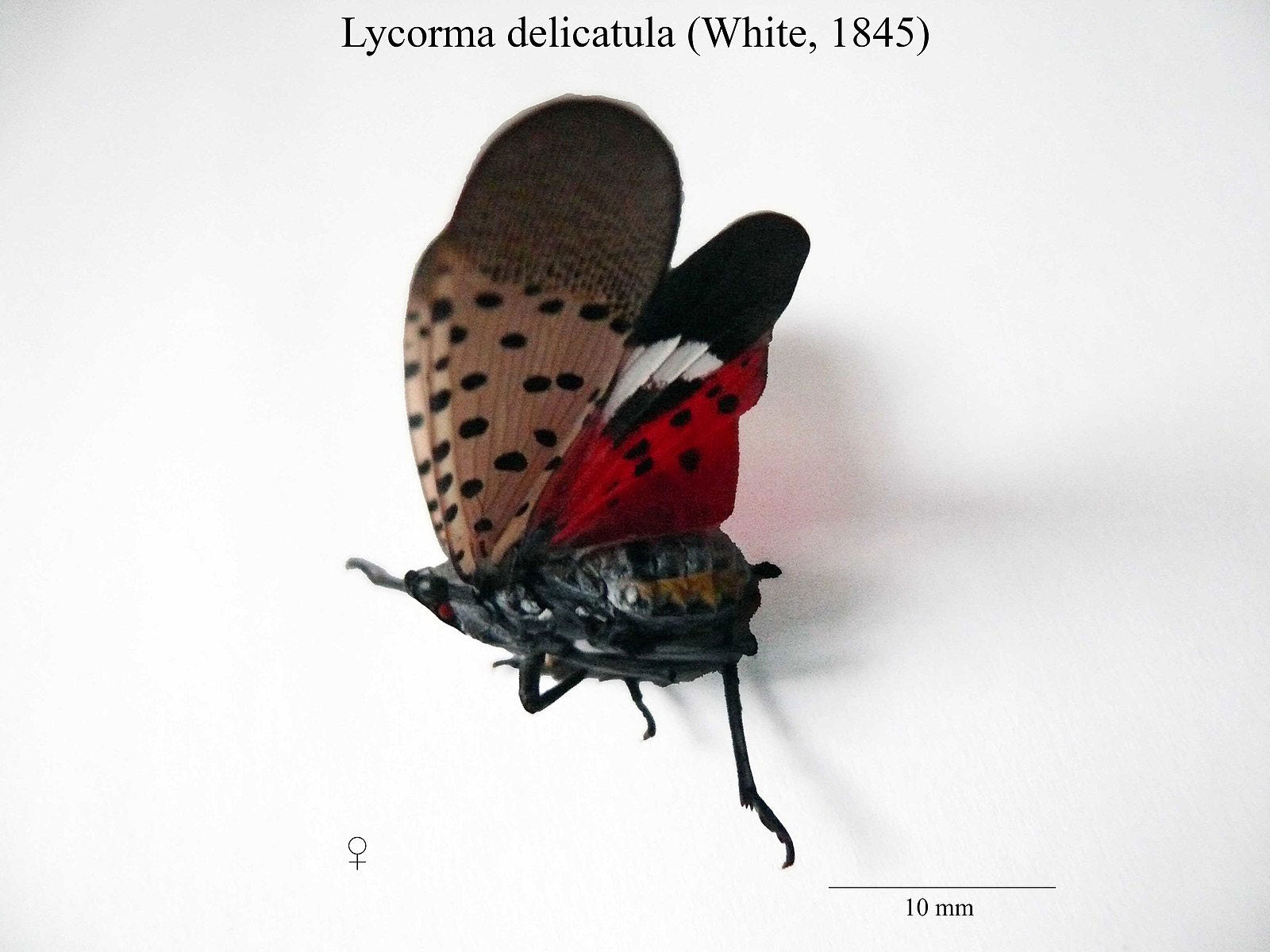The Spotted Lanternfly Poses A Threat to Agriculture and Ecosystems
Matthew Russell
Wikimedia Commons / Cbaile19
In recent years, Michigan has faced an alarming invasion that threatens not only its agricultural industry but also its natural ecosystems.
The spotted lanternfly, an invasive insect species with a voracious appetite for various plants, has made its way into the state, raising concerns among experts and farmers.
 Photo: Wikimedia Commons / Cbaile19, License: CC0 1.0 DEED
Photo: Wikimedia Commons / Cbaile19, License: CC0 1.0 DEEDThe Spotted Lanternfly (Lycorma delicatula) is an invasive insect.
A Recent Intruder: Spotted Lanternfly in Michigan
The spotted lanternfly's unwelcome arrival in Michigan was confirmed in 2022 when a small population was detected in Oakland County. This tiny insect has already wreaked havoc in other parts of the United States, making its presence in Michigan a cause for significant concern. But what exactly is the spotted lanternfly, and why is it so problematic?
Understanding the Spotted Lanternfly
The spotted lanternfly, scientifically known as Lycorma delicatula, is an insect that feeds on a wide range of plants, including grapes, apples, hops, and hardwood trees. Its discovery in the United States dates back to 2014 when it was first detected in southeastern Pennsylvania. Since then, it has rapidly spread to various states, including Connecticut, Delaware, Indiana, Maryland, Massachusetts, New Jersey, New York, North Carolina, Ohio, Pennsylvania, Virginia, and West Virginia.
 Photo: Wikimedia Commons / Cbaile19, License: CC0 1.0 DEED
Photo: Wikimedia Commons / Cbaile19, License: CC0 1.0 DEEDThe spotted lanternfly poses a significant threat to agriculture and ecosystems.
A Hitchhiker's Arrival
While the exact route of the spotted lanternfly's arrival in Michigan remains uncertain, it is believed to have hitchhiked on nursery stock brought in from infested states, Click on Detroit reports. This invasive pest may have been lurking in the state for several months before its detection.
According to the State of Michigan, traditional pest management techniques have proven ineffective in eliminating this resilient insect, making it even more challenging to control its spread.
 Photo: Wikimedia Commons / Cbaile19, License: CC0 1.0 DEED
Photo: Wikimedia Commons / Cbaile19, License: CC0 1.0 DEEDThe spotted lanternfly was first discovered in the United States in 2014 in Pennsylvania.
The Spotted Lanternfly's Threat
The spotted lanternfly poses a severe threat to Michigan's agriculture and natural resources. According to the Michigan Department of Agriculture and Rural Development, with an appetite for grapes, apples, hops, stone fruits, and more, it has the potential to devastate the state's farmers and food and agriculture industry. Additionally, its feeding habits are not the only cause for concern.
A Sticky Situation
According to North Carolina State University, One of the spotted lanternfly's distinct characteristics is its ability to secrete large amounts of sugary, sticky liquid called honeydew while feeding on host plants. This honeydew can have dire consequences, as it can kill plants and create a conducive environment for black sooty mold. Furthermore, the honeydew attracts various pests, including yellow jackets, flies, and ants. Thus, the spotted lanternfly's impact extends beyond its direct feeding habits.
 Photo: Wikimedia Commons / Alon-De-Lon, License: CC BY-SA 4.0 DEED
Photo: Wikimedia Commons / Alon-De-Lon, License: CC BY-SA 4.0 DEEDIn 2022, a small population of spotted lanternflies was detected in Oakland County, Michigan.
The Spotted Lanternfly's Lifecycle
Understanding the spotted lanternfly's lifecycle is essential for effective control measures. During late summer and until the first hard frost, these insects are in their adult stage, making them easier to identify. Adults are approximately one inch long and have gray to brown folded wings with black spots, according to the State of Michigan. When their wings open, a yellow and black abdomen and bright red hind wings with black spots become visible.
In the fall, spotted lanternflies lay egg masses that resemble old chewing gum with a gray, waxy, putty-like coating. Remarkably, these egg masses can survive harsh winter temperatures and hatch in the spring. Hatched eggs appear as brownish, seed-like deposits, and spotted lanternfly juveniles are initially wingless, black with white spots, and develop red patches in their final juvenile stage.
 Photo: Wikimedia Commons / Cbaile19, License: CC0 1.0 DEED
Photo: Wikimedia Commons / Cbaile19, License: CC0 1.0 DEEDThe insects are believed to have hitchhiked on nursery stock from infested states.
The Call to Action: What to Do When You Find a Spotted Lanternfly
If you happen to encounter a spotted lanternfly, whether in the form of an egg mass, juvenile, or adult, it is crucial to take immediate action. The U.S. Department of Agriculture recommends you start by documenting the sighting with several photos, making note of the date, time, and location.
The next step is perhaps the most critical: squish it.
Destroying spotted lanternflies helps prevent their further spread and protects agriculture and natural ecosystems. Once you have dealt with the insect, report your sighting online to your state Department of Natural Resources. Reporting is vital for tracking and managing the invasive species effectively.
The presence of the spotted lanternfly is not to be taken lightly. This invasive insect's potential to wreak havoc on agriculture and natural resources is a cause for concern.
In the battle against the spotted lanternfly, public awareness and active participation are vital. By taking these steps, we can work together to protect our agricultural resources and preserve their natural beauty for generations to come.
Matthew Russell is a West Michigan native and with a background in journalism, data analysis, cartography and design thinking. He likes to learn new things and solve old problems whenever possible, and enjoys bicycling, spending time with his daughters, and coffee.




















